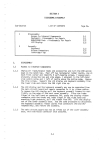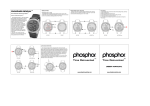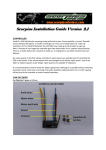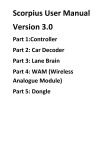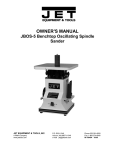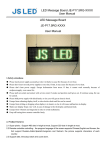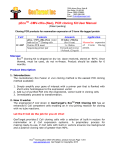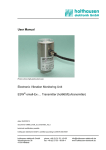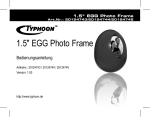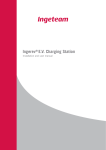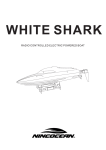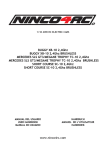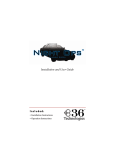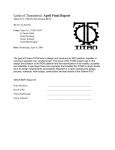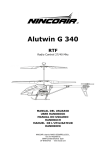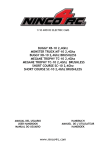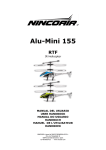Download Scorpius Installation Guide Version 1.7
Transcript
Scorpius Installation Guide Version 1.7 Updates on yellow since Version 1.5 Updates on green since Version 1.6 CONTROLLER Install 2 x AAA batteries by removing casing and knob screws. Ensure polarity is correct. Reinstall screws. Battry life approx. 500 hours. Press LC or brake button to “wake up” controller. On first install of batteries the controller may need up to 10 seconds to wake up. After 2 minutes of non-usage the controller goes into sleep mode, this is a power saving function, just press LC or brake button for 2 seconds to wake up. To change ID or any other functions see User Manual. CAR CHIP Car Chip has 7 wires as follows: Blue and white pair: Motor wires. Blue is positive, white is negative. Car should move in a forward direction once installed. If car goes in reverse swap motor wires around. A ferrite and capacitor similar to those used on Scalextric motors must be employed or the car decoder will perform poorly. Green and green pair: Braid wires. These can be soldered to existing wires or contacts or add eyelets depending on what brand of car. A ferrite and capacitor is optional here and demand will vary on motor type. Red and black pair with phototransistor attached: Installed 12mm offset to left as car is facing ion a forward direction and viewing from above the car whilst in an upright position. Use vernier callipers to mark distance from centreline of car to centre of LED hole position. Use 1mm drill bit as pilot hole before increasing to 3mm. De-burr car chassis hole from above before fitting and gluing phototransistor. Ensure face of phototransistor is on the same plane as the car chassis to maximise accuracy of lane changing and lap counting. Do this by holding bottom of chassis up to light and use reflections to get a better idea if the phototransistor is perpendicular to car chassis. The face of the phototransistor should be flush with the bottom of the chassis to maximise accuracy. Blue single wire: Antenna. It should be aiming away from PCB at 90 degrees if possible. Ensure no metal part of the car, eg axles, motor, magnet etc contact car decoder which should be fixed in place to prevent it from moving. We recommend hot glue or any glue that can peel away and leave a clean surface later. Do not use Superglue, Zap or similar glues. These make it impossible to remove the phototransistor without damaging the chassis. These glues also emit a vapour that permanently fogs the lens, which will result in poor lap counting and lane changing. Be careful that chassis is locked flat to workbench when using hot glue as too much glue for too long can bend the chassis. This is critical on non-magnet cars especially. The default ID on the car decoder is #1. To change car decoder ID transfer controller ID to car, to re-flash car decoder or any other function refer to User Manual. Car Decoder Installation Car Decoder “sensor” which is a phototransistor has its hole drilled 12mm to the left of centre looking from the top view and in a forward direction. Note antenna leaving pcb at 90 degrees. Optional motor can earth wire installed. Spare earth pads on the rear if the car decoder, the 2 large shiny areas. Earth wire soldered onto pad. TRACK POWER 1) 12V is connected directly to rails. Positive is the right rail looking from the top view in a forward direction. The power supply should be rated to 3A per car. Eg 6 cars you will need 18A. The power supply must have a cut out or current limiting device included. External fuses should be avoided if possible. Red wire is positive. Black wire is negative. DONGLE The dongle requires a driver be installed which is included on the CD supplied or from the website. Click on the CP-210X program and follow the prompts. Once installed plug the dongle into any USB port. The computer will automatically find the correct com port for you. Only one program can be opened at any one time with one dongle. Two programs can operate simultaneously with 2 dongles. To test dongle, go to Throttle Test program and use a controller to see if dongle is picking up signal. Remove dongle housing for better transmission results. Important. Dongle should be in an elevated position in room in view of the start finish line. Use 2, 3 or 5 metre USB extension cable. Important. Removing dongle from PC before closing program may cause computer to freeze. LANE BRAIN The Scorpius Lane Brain can be used for 2 purposes i)Lap-counting Lane Brain needs to be set to ID 0 using the LB set up program supplied. Install LEDs as you would for any lane changer. When the car passes over the LED beacons, the car will send a lap count signal to the PC. ii) Lane change functions Lane Changer Lane Brains can be configured to transmit on Channels 1-32 The Lane Brains can have their ID configured using the LB set up program. Lane Brain Wiring The Lane Brain has 20 wires. 1-2) Power in, red is positive, black negative. Use 8-16V DC. Use only the same power supply thast drives the track. Power can be taken from adjacent rails. Do not power Lane Brains from an independent power supply. It is important that the voltage to cars and Lane Brains is identical anywhere from 8-16V DC. 3-10) Solenoid driver wires. There are 4 pairs of solenoid wires. Lane 1: A & B Car to go straight green pair. Car to change lanes black pair. Lane 2: A & B Car to go straight orange pair. Car to change lanes blue pair. Remember to go straight Ninco uses a sprung flipper and Carrera a mechanical switch, here those wires not required can be trimmed off and ends insulated, or de-solder from board if skillful enough. SSD XLC : 4 pairs of solenoid wires will be employed SSD CLC: 2 pairs of solenoid wires will be employed. Ninco XLC or double CLC: 2 pairs of solenoid wires will be employed. Green for lane 1 and orange for lane 2. The other pairs are not required. Ninco single LC: 1 pair of solenoid wires will be employed. Green for lane 1 or orange for lane 2. The other pairs are not required. Carrera XLC: 2 pairs of solenoid wires will be employed. Green for lane 1 and orange for lane 2. The other pairs are not required. Carrera single LC: 1 pair of solenoid wires will be employed. Green for lane 1 or orange for lane 2. The other pairs are not required. Timber tracks: If using Peco solenoid (which is actually 2 solenoids in one unit) 2 pairs of wire per solenoid will be employed. SCX: Scorpius cannot be used with SCX digital track system. Each solenoid can be wired in any polarity. Note the set up program allows the power to left and right solenoid (in the same lane) to be swapped should they be wired in reverse. A handy tool. 11-18) LED Beacon wires, 4 pairs, each pair one colour and black as earth. The LEDs are factory fitted. Polarity must be observed if shortening or modifying wiring. If unused LEDs are removed the wire pair must be soldered together and insulated. This is because the LEDS are wired in pairs in series. Removing an LED will create an open circuit resulting in non-operation. 19-20) Liven flipper wires: Lane 1 wire goes to flipper in lane 1. Repeat for lane 2. Liven flipper does not suit Ninco or Carrera LCs. It is best suited to 2 solenoid per flipper type lane changers such as SSD. Reset switch: Should be installed within easy reach for use when reconfiguring Lane Brain. Polarity to this switch is not critical. Extend wires if needed. Power on LED: A green LED shines when the unit is turned on. Straight and Change are solenoid wires. Do not mix wires from colour set to another. Placement of LEDs in track. LED snap off board. Trim as required to fit your situation. Use only hot glue on plastic tracks for easy removal. Use double sided tape on timber tracks to install. Adding additional LEDs to the Lane Brain. Where cars slide on corners add additional LEDs in series or as shown below. LED board before adding additional LED LED board after adding LEDs and moving earth wire as shown. Delete picture above Delete picture above. Bridging wire are only added if ONE led is to be added. Lane Brain Install tips: 1) Anti-collision Led beacons must be installed if anti-collision box is ticked during configuration. If they have been installed and anti-collision is not required then they must be covered sufficiently enough to stop LED light penetrating. If the car detects an anti-collision beacon and it is not configured to anti-collision mode the operation will be impaired. 2)Use hot glue to attach LED beacon boards to underside of plastic tracks. It removes and cleans up easily. 3)Assemble one LC/LB at a time, fully test in situ before proceeding to the next one. 4)Each LB must be assigned a unique ID. Start/finish line is always 0. Any other lane changer can be assigned any ID from 1-32 in any order. It is common sense however to have the first LC after the start called #1, 2nd LC, #2 etc. Put a sticker for reference so if you need to re set the ID in future you can easily tell the correct number. 5)Lane Brains must be enclosed for rug racing. Nylon carpet and debris will cause PCB failure. 6)When re-flashing the LB, make sure the laptop is elevated off the floor and not within a metre. This seems to give better results. 7)Reset button. If pressed put the LB into boot mode, ready to be re-flashed or reconfigured. 8)Each time you re-flash or reconfigure each LB you must turn off the power supply for 5 seconds and back on. This switches it from boot mode into operation mode. 9)Each time the LB goes into boot mode it will start operating any flippers back and forth after 10 seconds. This does 2 things. Firstly it shows it went into boot mode. Secondly it proves if solenoids are working. 10)If the LB power wires are attached and the green LED is not lit it means the polarity is incorrect, or a faulty LB. 11) The antenna wire should be proud or to the side of the PCB and not laying across it. And at right angles if possible. 12) 2 ten connector plugs can be used to separate LC wires to LB wires for a “Quick Release” set up. 13)When reconfiguring multiple LBs in one go you can leave the switching off/on of the LBs to the end to save turning off on each time. Only downfall here is each LC will ‘click-clack” until they are reset to operation mode. This isn’t an issue, only noisy! 14)Use vernier callipers to accurately mark out position of LED holes in track and phototransistor hole in car chassis. Use 1mm bit as pilot hole before increasing track LED beacons to 6mm dia. And car chassis to 3mm. De-burr car chassis hole from above before fitting and gluing phototransistor. For very fast track sections increase their hole size to 7-8 mm in diameter to maximise the window of opportunity that the phototransistor has to see the LED in the track as it passes over. The biiger the diameter of the hole the deeper the LED shpuld go. See diagram. 15)Use multimeter to check polarity of wires before and after connection of power wires. 16)Install LEDs flat approx. 4-5mm from the track surface. The dot in the centre of the LED should be the centre of the hole. 17)LEDs should be fixed with double sided tape in a specially routed rebate in the underside of track. It is important the LED is 3-6 mm from the track surface depending on the speed of that particular track section. Reset switch Used in conjunction with reflashing and reconfiguring processes only. Antenna Should be at 90 degrees to PCB if possible. Lane Brain Set up program. See User Manual END OF DOCUMENT













